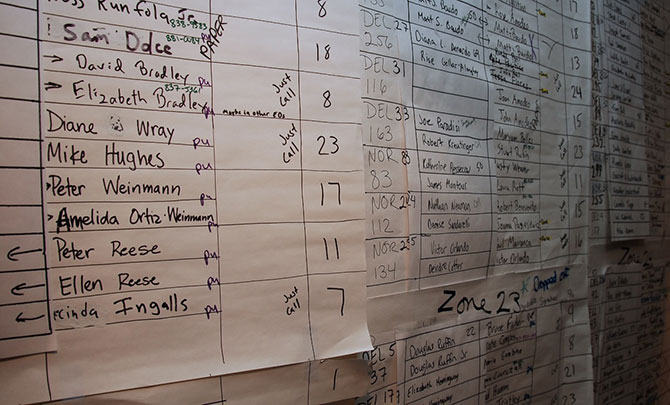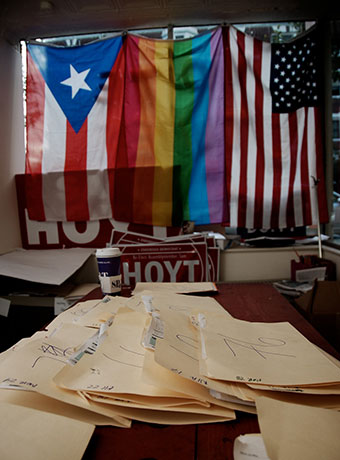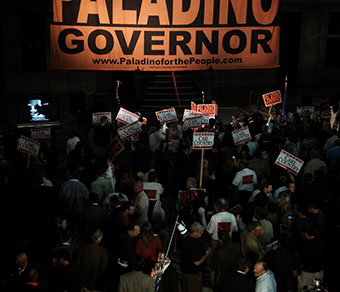Next story: Our Money, Our Jobs, Our Water
Primary Numbers
by Geoff Kelly

Observations on Tuesday’s primary elections
IT’S PALADINO’S PARTY NOW: You know what happened here. There’s a lot more space online to ponder the future of New York’s Republican Party, the mechanics of Paladino’s primary victory, his chances against Andrew Cuomo, and what happens even if he loses. So check Artvoice.com—and every other media outlet in town and across the state—if that’s what you want to read. Here, we’re looking at Tuesday’s other big races.
HOYT 5,174, GOLOMBEK 4,921:Turns out North District Councilman Joe Golombek has not surrendered his race against Assemblyman Hoyt just yet: Despite his concession last night, Golombek has obtained a court order impounding the voting machines for a recount, according to an email distributed by campaign staffer Paul Wolf, and he’s hoping absentee ballots might help him close the 253-vote gap between him and Hoyt.
But the odds are heavily against the absentee ballots changing the outcome, so we’ll look at the numbers as they stood Wednesday afternoon, with the understanding that they will change but that Hoyt will win.

Things looked grim for Hoyt on Tuesday morning, as voters flooded the polls early in Golombek’s North District base. Meantime, the turnout in Hoyt’s Delaware District base was initially thin. However, as afternoon turned to evening, that trend reversed, as Hoyt’s supporters hit the polls—some of them perhaps responding to Hoyt’s Facebook messages imploring them to vote—and the North District dried up. At seven o’clock, two of Mayor Byron Brown’s chief political operatives, Deputy Mayor Steve Casey and Peter Savage III, were working the phones hard at Golombek’s Hertel Avenue headquarters, while a sense of calm prevailed at Hoyt’s base on Elmwood Avenue. Though the final (unofficial) tally was close, Golombek conceded quickly. No doubt he saw the same things Hoyt’s operatives saw as they posted the numbers on the big board they’d pinned to the wall on the second floor of Casa di Pizza: The election districts in which the candidates were strong counterbalanced, and Golombek was making insufficient headway in the election districts that were split. There were no great influxes of votes coming to push him over the top.
Golombek managed to get 394 more votes then he received in 2004, when he last challenged Hoyt. Hoyt, meantime, received 164 fewer votes than he received in 2004. Turnout was about 1.8 percent higher in Tuesday’s race compared to 2004.
There’s a more interesting comparison to be made: Barbra Kavanaugh’s 2008 challenge was backed by massive logictical and financial support from Tom Golisano, Steve Pigeon, and Mayor Byron Brown’s political operation. In the final tally, Kavanaugh outstripped Golombek’s 2004 performance, but Hoyt trounced her anyway with 5,946 votes.
The fact that Hoyt’s campaign brought 800 fewer voters to the polls than it had two years ago speaks to the frustration voters feel toward incumbents and state government generally. But there are other forces at play here, too. Hoyt worked hard on that 2008 campaign, possibly harder than he did this year. But he benefitted also from the impression that he was being targeted by a financial juggernaut—Golisano’s Responsible New York committee, managed by Pigeon, which spent nearly a half million dollars against Hoyt in 2008 and more than $4 million statewide—which went too far in exploiting Hoyt’s extramarital affairs. Big outside money never materialized for Golombek. He had support from the mayor and his political machine, which helped get him on the ballot and staff his campaign, but that was about it. Golombek worked until the last hour—he personally knocked on 5,600 doors this summer—but it wasn’t enough. If outside support had materialized, it might have bought Golombek some more votes. But it might have provoked more Hoyt supporters to go to the polls, too, as it did in 2008.
PIGEON POUNDS THE PAVEMENT: Steve Pigeon, the hardest-working man in New York politics, was spotted Tuesday handing out literature for his boss, State Senator Pedro Espada, at a polling place in the Bronx. (YNN’s Liz Benjamin posted a photo Espada lost to his primary challenger, Gustavo Rivera, despite allegations of Espada supporters trying to intimidate and trick voters into voting for their man. Espada’s loss means Pigeion will lose his $150,000-a-year job as the Senate majority leader’s counsel, a position Pigeon landed in the wake of the 2009 leadership coup led by Espada and disgraced former State Senator Hiram Monseratte—who also lost Tuesday in his bid for a vacant Queens Assembly seat.
THOMPSON WINS, ALLEN AND COPPOLA SPLIT: Both Rory Allen and Al Coppola accused the other of splitting the opposition to incumbent State Senator Antoine Thompson, but it hardly mattered which one was the spoiler: With 99 percent of the votes counted, Thompson had garnered 13,487 to Allen’s 6,040 and Coppola’s 4,711. Even taken together, there wasn’t enough opposition to unseat Thompson.

But there was considerably more opposition this year than there was when Mark Grisanti challenged Thompson in the Democratic primary two years ago. Grisanti managed 6,838 votes in 2008, while Thompson pulled in a whopping 18,083. So Thompson attracted 7,500 fewer votes this year, while 5,000 more people went to the polls to vote for his opponents.
Grisanti is challenging Thompson in November’s general election, running on the Republican line. Thompson supporters can’t rest easy on this race, despite the vast enrollment advantage they have over Republicans in the district: Tuesday produced an epidemic of Democrats across the region coming to the polls to try to vote for Carl Paladino in the Republican gubernatorial primary—which of course they could not do—and many of them will come back in November, and they will not be disposed to vote for Thompson. Add a high local turnout for Republicans generated by Paladino’s candidacy, as evident on Tuesday, and all local Democrats, Thompson included, will have to work for their votes.
KENNEDY MOVES ON TO QUINN: No sense in crunching numbers on this race: Kennedy slayed the opposition, outgaining incumbent State Senator Bill Stachowski by better than a two-to-one margin. Fellow Democrats Mike Kuzma and Tom Casey were marginal presences. So Kennedy faces Republican Assemblyman Jack Quinn III in November, who will be well financed and well situated to win in that district. Quinn will also reap the benefits of Paladino occupying the Republican line for governor. This becomes the local race to watch, as Republicans and Democrats vie for control of the State Senate and next year’s post-Census statewide redistricting.
NEW JUSTICE IN CHEEKTOWAGA?: In the race for Cheektowaga Town Justice, former Buffalo Police cold case detective Dennis Delano won all three of his primaries—Republican, Conservative, and Working Families—against Democratic incumbent James Vallone.
With those three lines, his popularity, and the anticipated Paladino effect on Cheektowaga voters, Delano stands a good chance of replacing Vallone in November.
OBSERVED AT THE ELLICOTT SQUARE BUILDING: Two men dressed in the colonial garb that many Tea Partiers affect. Neither of them was Grand Island’s Rus Thompson.
—geoff kelly
blog comments powered by Disqus|
Issue Navigation> Issue Index > v9n37 (Health & Fitness Issue, week of September 16) > Primary Numbers This Week's Issue • Artvoice Daily • Artvoice TV • Events Calendar • Classifieds |









 Current Issue
Current Issue